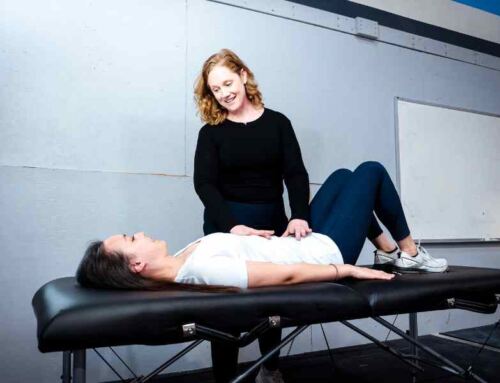Bladder Prolapse Guide: Understanding and Managing Pelvic Organ Prolapse (POP)
Have you ever felt an unexplained pressure or heaviness in your pelvic area? Maybe you’ve noticed urinary issues or discomfort that just doesn’t seem right. What if these symptoms are your body’s way of signaling a condition you’ve never even heard of? Bladder prolapse, a type of pelvic organ prolapse (POP), is far more common than most realize, yet it often goes undiagnosed. In this quick guide, I’ll break down everything you need to know about bladder prolapse, from early symptoms to effective treatment options, empowering you to take control of your pelvic health.
I’m a physical therapist who specializes in treating the pelvic floor, which includes addressing issues with the bladder, bowel, reproductive organs, and pain in the lower back, sacroiliac joint (SIJ), and hips.
One population that frequents my clinic is women (and those assigned female at birth) with Pelvic Organ Prolapse (POP). A POP occurs when the muscles and tissues supporting the pelvic organs become weakened or stretched, causing these organs to drop (prolapse) into or out of an opening in the pelvis. The most common type is a cystocele, where the bladder prolapses down into the vaginal canal. While there are general signs and symptoms across all types of POP, some are specific to a cystocele.

Signs and Symptoms of Bladder Prolapse
- Feeling of pressure, fullness, heaviness, or dragging in the vaginal or pelvic area. This can be more noticeable when standing or walking (especially for prolonged periods) and may improve with lying down.
- Feeling of bulging in the vagina which may worsen when bearing down or straining.
- Urinary leakage, especially with coughing, sneezing, laughing, or jumping
- Increased urinary frequency
- Recurrent urinary tract infections (UTIs)
- Pain or discomfort during intercourse, gynecological exam, or use of tampon
- Low back pain
- Urinary retention or feeling of incomplete emptying
Unfortunately, many of my patients don’t even realize they have a prolapse, let alone know how to treat it.
I wrote this article as a guide to help those who may be struggling with these symptoms and/or this diagnosis.
Before anything can be done to help, it’s important to get a diagnosis from a healthcare professional so you know what you’re dealing with. This allows you to create a tailored plan of care that will fit your specific needs and help you capitalize on all the resources available.
How to Get A Diagnosis
Luckily, several types of healthcare providers can assess and diagnose a POP, including:
- Primary care providers like MDs, NPs, or PAs
- OBGYNs
- Urogynecologists
- Urologists
- Pelvic Floor Physical Therapists
During your appointment, your healthcare provider will begin with a detailed view of your medical history. After that, here’s what you can expect:
Pelvic Exam
This may include a strength assessment of the pelvic floor, use of a speculum for better visualization, and asking you to bear down while lying down or standing, which can reveal less severe cases that may otherwise be missed.
POP-Q
The POP-Q is a tool that identifies the severity or grade of your prolapse. Your score will dictate your treatment and prognosis and can be used to track improvement after treatment. There’s even an interactive online version where you can input your results for a more detailed view of your case, here.
Discussion on next steps
Based on your exam, your provider will discuss your treatment options and help connect you to the necessary resources.

Treatment Options
Treatment for bladder prolapse depends on the severity, your personal preferences, and how much it’s impacting your quality of life. While surgery may be necessary in severe cases, there are several other things that can be done to address your symptoms without going under the knife.
Things to Avoid
- Straining. Chronic coughing and constipation are major culprits that increase intra-abdominal pressure, which can significantly weaken the supportive tissues holding up your bladder.
- Heavy lifting. Repeated heavy lifting, especially without proper form or support, can negatively impact your symptoms and worsen the severity of your prolapse.
- Obesity. Excess abdominal weight increases intra-abdominal pressure, which weakens support structures, overstretches pelvic floor muscles, and can contribute to hormonal imbalances that affect pelvic tissue integrity.
Other Treatment Approaches
- Hormonal creams or suppositories. Estrogen plays a vital role in maintaining the health and function of pelvic tissues, particularly in women. It helps maintain tissue elasticity, promotes blood flow, strengthens vaginal and urethral walls, supports pelvic floor muscle function, and reduces inflammation. Who knew such a little molecule could do so much??
- Pessary for internal support. Pessaries are small devices made of silicone or other flexible materials that are inserted vaginally to provide internal support for the bladder. There are several types, and your healthcare provider can help determine the best one for you. Learn more about them here.
- See a Pelvic Floor Physical Therapist (PFPT). PFPTs specialize in addressing pelvic dysfunction, and prolapse falls well within that category. They can help by strengthening the pelvic floor muscles, providing manual therapy for restricted tissues, teaching proper posture and body mechanics, and offering advice on lifestyle changes and symptom management.
Conclusion
Pelvic organ prolapse is a common yet often misunderstood condition that can significantly affect quality of life. Navigating this condition can feel overwhelming, but it’s important to remember that you don’t have to go through it alone! While the symptoms can be uncomfortable and challenging, there are numerous effective treatments and management strategies available to help.
Whether you’re just beginning to notice symptoms, have already been diagnosed, or have other concerns about your pelvic floor, seeking help from a qualified pelvic floor physical therapist is a crucial first step.
We can help you explore treatment options, provide education and a personalized plan of care, and be your ultimate cheerleader throughout the process.
If you’re located in North Carolina, contact me to set up an appointment to see how we can improve your quality of life together. By taking steps to understand your condition and seek professional support, you’re already on the path to feeling better and getting back to doing what you love.
References
- Shull BL. Pelvic organ prolapse: Clinical management and outpatient therapy. Obstet Gynecol. 2002;99(3):465-472.
- Nitti VW, Rovner ES. Estrogen and the Lower Urinary Tract. Urology. 2001;57(6):73-79. doi:10.1016/S0090-4295(01)01125-5.
- Northington GM, Bump RC. The Role of Estrogen in Pelvic Floor Dysfunction. Clin Obstet Gynecol. 2004;47(2):339-347. doi:10.1097/01.grf.0000126938.75412.71.
- Shull BL. Pelvic organ prolapse: Clinical assessment and management. Lancet. 1999;354(9188):1250-1256. doi:10.1016/S0140-6736(98)10044-2.
- Hendrix SL, Clark A, Nygaard I, et al. Pelvic organ prolapse in the Women’s Health Initiative: Gravity and gravidity. Am J Obstet Gynecol. 2002;186(6):1160-1166. doi:10.1067/mob.2002.122591.
- Swift S, Tate S, Nichols J, et al. Correlation of symptoms with degree of pelvic organ support in a general population of women: What is pelvic organ prolapse? Am J Obstet Gynecol. 2003;189(2):372-377. doi:10.1067/s0002-9378(03)00306-6.
- Fritel X, Varnoux N, Zins M, Breart G, Ringa V. Symptomatic pelvic organ prolapse at midlife, quality of life, and risk factors. Obstet Gynecol. 2009;113(3):609-616. doi:10.1097/AOG.0b013e318197b508.
- Lukacz ES, Lawrence JM, Contreras R, Nager CW, Luber KM. Parity, mode of delivery, and pelvic floor disorders. Obstet Gynecol. 2006;107(6):1253-1260. doi:10.1097/01.AOG.0000218096.54169.34.
- Swift S, Woodman P, O’Boyle A, et al. Pelvic organ support study (POSST): the distribution, clinical definition, and epidemiologic condition of pelvic organ support defects. Am J Obstet Gynecol. 2005;192(3):795-806. doi:10.1016/j.ajog.2004.11.049.
- Barber MD, Maher C. Epidemiology and outcome assessment of pelvic organ prolapse. Int Urogynecol J. 2013;24(11):1783-1790. doi:10.1007/s00192-013-2169-9.
About the Author
Dr. Mattie Overton is a physical therapist in Durham, North Carolina. With over 15 years experience, she has a track record of helping a wide variety of patients live their best with added expertise in pelvic health, vestibular, and neurological treatments. If you’re looking for an ideal partner on your journey to wellness, look no further than Dr. Mattie Overton.








